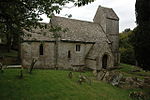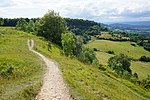Brimpsfield
Cotswold DistrictGloucestershire geography stubsUse British English from March 2015Villages in Gloucestershire

Brimpsfield is a village in Gloucestershire, England. The village is recorded in Domesday Book as Brimesfelde. Brimpsfield Castle was built in the village during the Norman period. The manor of Brimpsfield was granted to Maurice de Berkeley in 1339 by King Edward III.The Church of St Michael was built in the 12th century. It is a grade I listed building.A fictional Brimpsfield is the home village of Peter and Abby Grant in the 1970s BBC TV series Survivors; it is shown to have a railway connection to London.
Excerpt from the Wikipedia article Brimpsfield (License: CC BY-SA 3.0, Authors, Images).Brimpsfield
Cotswold District
Geographical coordinates (GPS) Address Nearby Places Show on map
Geographical coordinates (GPS)
| Latitude | Longitude |
|---|---|
| N 51.8 ° | E -2.1 ° |
Address
GL53 9PR Cotswold District
England, United Kingdom
Open on Google Maps








